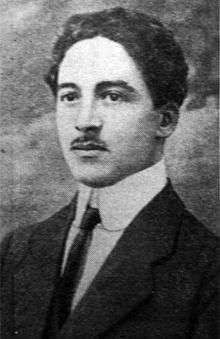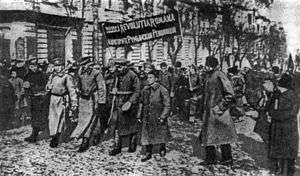Alexandru Nicolau
Alexandru Nicolau (Russian: Александр Александрович Николау; January 1889 – September 27, 1937) was a Romanian lawyer, socialist and later communist activist. Active in the Romanian and French socialist movements before and during World War I, he left for Russia during the 1917 Revolutions. There, he became one of the organisers of Romanian volunteer detachments in support of the Soviets. Arrested shortly after returning to Romania in 1920, he left for Soviet Russia after a successful prison escape. During the later part of his life he held teaching positions at several Soviet universities, before falling victim to the Great Purge in 1937. His name was posthumously rehabilitated both in the Soviet Union and in his native Romania.
Alexandru Nicolau | |
|---|---|
 | |
| Born | January 1889 |
| Died | September 27, 1937 (aged 48) |
| Nationality | Romanian, Soviet |
| Occupation | lawyer |
Biography
Early life and activity
Nicolau was born in Bucharest in 1889. As a student at the Saint Sava High School, he befriended Constantin Titel Petrescu and Mihail Cruceanu, both of whom would later become known as socialist militants.[1] After finishing his secondary education, Nicolau trained as a lawyer, receiving a degree from the local University, a PhD in Paris, before being admitted to the Bucharest Bar. His first contacts with the Romanian socialist movement, still in disarray during that period, came through his membership in the Bucharest's Study Circle of the Socialist Students between 1908 and 1909. Soon after he began writing for România Muncitoare, the main socialist press venue. One of his first notable contributions was his correspondence from Italy, criticising the reformist stance of the local socialist party.[2] In 1911, România Muncitoare published Nicolau's anti-militarist manifesto To the recruits.[3] Recalling the army's contribution in suppressing the 1907 Peasants' revolt, the brochure called on the new recruits to choose a different path and refuse to support the government crackdown on the demands of the workers and the peasant. As a result, in May 1912 he was put under trial before the Court of the Ilfov County, where he reaffirmed the ideas expressed in the manifesto. Defended by fellow socialists Mihail Gh. Bujor, Toma Dragu and Titel Petrescu, and by socialist sympathizer Constantin Mille, Nicolau was eventually acquitted by the jury.[4][5][6] In June 1912, along with Constantin Dobrogeanu Gherea, Ecaterina Arbore and others, he represented the Bucharest Socialist Club at the Fifth Congress of the Social Democratic Party of Romania (PSDR),[7] being elected a member in the committee of the party's publishing house.[8] In order to escape harassment from the authorities, Nicolau chose to leave Romania for Paris, where he continued his law studies at the Sorbonne, and joined the French Section of the Workers' International.[9][10][11]
World War I and Russian Revolution
In 1916, Romania joined World War I on the side of the Entente and imposed an immediate ban on the local socialist movement, which had adopted a militant pacifist stance. Nicolau reacted by publishing in Paris a study highly critical of the Romanian ruling classes, titled The Crime of the Romanian Oligarchy. Returning to Romania later in the war, he was kept under constant surveillance by Siguranța, the secret police.[10] Nicolau was present in Iaşi during the revolutionary agitation which emerged during the 1917 May Day celebrations and under the impression of the February Revolution. Along the other social-democrats, he supported the position of the PSD leader Christian Rakovsky, who believed the situation in Romania was not ripe for the overthrow of the monarchy.[12][10]

Joining Christian Rakovsky and Bujor, Nicolau left in June 1917 for Russia,[13] where he entered the Russian Social Democratic Labour Party (bolsheviks).[14] He settled in Odessa and, along with Bujor, Ion Dic Dicescu, and Alter Zalic, he was one of the organisers and afterwards leaders of the Romanian Committee for Social-Democratic Action established in the city.[15][10][3][14] Nicolau also became the editor of Lupta ("The Struggle"), which presented itself as the successor of România Muncitoare (renamed in 1914 to Lupta zilnică, "The Daily Struggle").[10][3] After the October Revolution, the Romanian socialists in Odessa saluted the new developments. Becoming increasingly communist in outlook, they also began agitating for a revolution in their home country.[16] Such views were publicly expressed by Nicolau during his speech at the 2nd Congress of Rumcherod.[11] In order to help the Soviets secure power in Southern Russia, on December 28, 1917, the Committee established the Romanian Revolutionary Military Committee, which counted Nicolau, Bujor, and Dicescu among its leaders.[17] The Revolutionary Committee worked in close cooperation with the Rumcherod, which provided it with material support.[18] During the following period, two Romanian volunteer battalions were established by recruiting Romanian soldiers in Bessarabia and the Russian Black Sea ports, as well as workers who had been evacuated to Southern Russia.[10][19][20] Between January and March 1918, the volunteers participated along the local Red Guards in battles against the troops of the Ukrainian People's Republic, the regular Romanian Army which had occupied Bessarabia, as well as against the Central Powers armies advancing from the Northwest.[21]
The occupation of Odessa by Austro-German troops in the aftermath of the Treaty of Brest-Litovsk forced the volunteer battalions to retreat to Crimea and central Russia, with the members of the Action Committee either going underground or leaving for Russian areas still under Soviet control.[22] In August 1918, Nicolau, Dicescu and the other former members of the Action Committee which had reached Moscow created the Romanian Communist Revolutionary Committee. The new committee, proclaimed the official representative of the PSDR in Russia, established contacts with the socialists in Bucharest and initiated an outreach campaign amongst the Romanian POWs in Russia. In late 1918, the Committee joined another Romanian group, the radical agrarian Romanian Revolutionary Peasants' Party, to form an unified Romanian Communist group of the Russian Communist Party (bolsheviks). Nicolau was elected the group's chairman, with another PSDR member, Ion Penţa, being elected secretary and representative to the Federation of Foreign Groups. Nicolau also began publishing regularly in Foaia ţăranului, the former organ of the Revolutionary Peasants' Party.[23] In 1919 the Publishing House of the Romanian Communist Groups in Soviet Russia published Nicolau's brochure The Socialist Revolution in Romania.[10] The pamphlet acknowledged the Bolshevik support for the Romanian communists, and called on Romanians to follow the revolutionary path taken by the Russian communists under the leadership of Lenin.[24] During August 1919, as the Soviets regained Odessa, Nicolau was one of the editors of the short-lived newspaper Scânteea.
Later life and death
Alexandru Nicolau returned to Romania in 1920, however he was soon apprehended by the authorities, and imprisoned in Jilava along with a larger group of communists, including Alecu Constantinescu. The group made a successful bid for escape on the night of December 2, 1920, and, following a short stay in Bulgaria, most escapees made their way to Moscow.[10][3] On March 31, 1931, Nicolau was sentenced in absentia to death by the Romanian authorities.[25] In Soviet Russia, he joined the local group of Romanian communists, and participated as a non-voting delegate in the Third World Congress of the Communist International, held in Moscow in June 1921.[26] Nicolau also joined the Romanian section of the Communist University of the National Minorities of the West, where he lectured on topics such as history and social sciences, and worked as a teacher for the Moscow Institute of Foreign Languages.[9][25]
Nicolau was among the Romanian Communist refugees in Soviet Russia who in 1924 signed a memorandum calling for the creation of a Moldovan national territory inside the Ukrainian Soviet Socialist Republic, near the disputed border with Romania. Along with Dicescu, the main author of the document, Nicolau considered Moldovans to be Romanians, and saw the new polity primarily as a base for propaganda across the Dniester, in Bessarabia and Romania. Such views were however rejected by the Bessarabian Communists who, after gaining the support of the Ukrainian leadership, enforced a cultural policy emphasizing the distinctiveness of Moldovan identity in the newly created Moldovan Autonomous Soviet Socialist Republic.[27]
Arrested on August 14, 1937, during the Stalinist purges, Nicolau was sentenced to death on September 27, 1937, by the Military Collegium of the Supreme Court of the USSR on fabricated charges of "espionage and involvement in counter-revolutionary terrorist organisations". He was executed on the same day, and buried in the Donskoy Cemetery in Moscow.
He was posthumously rehabilitated on September 15, 1956, through a decision of the Soviet Supreme Court during the De-Stalinisation campaign.[9] In a symbolic gesture, his name was also rehabilitated in Romania during the April 1968 Plenary Session of the Central Committee of the Romanian Communist Party.
Notes
- Cruceanu 1973, p. 131.
- Popescu-Puţuri & Georgescu 1971, pp. 267-268.
- Liveanu 1967, p. 895.
- Calendarul Muncei 1913, p. 89.
- Popescu-Puţuri & Georgescu 1971, pp. 269-271.
- Petrescu & n.d, pp. 245-246.
- Bacalbaşa 1936, p. 95.
- Calendarul Muncei 1913, p. 65.
- Memorial.
- Popescu-Puţuri & Georgescu 1971, p. 271.
- Manusevich et al. 1967, p. 410.
- Matichescu 1967, p. 870.
- Petrescu & n.d, pp. 292-293.
- Manusevich et al. 1967, p. 67.
- Unc 1967, p. 847.
- Unc 1967, p. 848.
- Manusevich et al. 1967, p. 411.
- Manusevich et al. 1967, p. 412.
- Unc 1967, p. 849.
- Manusevich et al. 1967, pp. 413-414.
- Manusevich et al. 1967, pp. 414-415.
- Manusevich et al. 1967, p. 416.
- Manusevich et al. 1967, p. 418.
- Manusevich et al. 1967, p. 419.
- Popescu-Puţuri & Georgescu 1971, p. 272.
- Stănescu 1971, p. 61.
- Galuschenko 2009.
References
- Calendarul Muncei pe anul 1913 [Labour almanac 1913] (in Romanian). Bucharest: Cercul de Editură Socialistă. 1913.
- Bacalbaşa, Constantin (1936). Bucureştii de altă dată 1910–1914 [The Bucharest of yesteryear 1910–1914] (in Romanian). IV (2 ed.). Bucharest: Editura Universul.CS1 maint: ref=harv (link)
- Cruceanu, Mihail (1973). De vorbă cu trecutul... [Talking to the past...] (in Romanian). Bucharest: Editura Minerva.CS1 maint: ref=harv (link)
- Galuschenko, Oleg Sergeevich (2009). Молдаване или Румыны? Взаимоотношения между бессарабцами и румынскими политэмигрантами накануне создания Молдавской АССР [Moldavians or Romanians? Interrelations between the Bessarabians and the Romanian political emigrants before the creation of the Moldavian ASSR]. Приднестровье XXI (in Russian). Tiraspol: Tiraspol School of Political Studies (20). Archived from the original on 21 February 2014. Retrieved 3 February 2014.CS1 maint: ref=harv (link)
- Liveanu, V. (1967). "Pravda despre mişcarea revoluţionară din România (1917–1921)" [Pravda about the revolutionary movement in Romania (1917–1921)]. Studii. Revistă de istorie (in Romanian). Bucharest: Editura Academiei Republicii Socialiste România. XX (5): 891–904. ISSN 0567-6304.CS1 maint: ref=harv (link)
- Manusevich, A. Ya.; Birman, M. A.; Klevanskiy, A. Kh.; et al., eds. (1967). Интернационалисты: Трудящиеся зарубежных стран — Участники борьбы за власть советов [The internationalists. Workers of the foreign countries — participants in the battle for Soviet power] (in Russian). Moscow: Nauka.CS1 maint: ref=harv (link)
- Matichescu, O. (1967). "Acţiunile revoluţionare din Iaşi desfăşurate în cursul lunii Mai 1917" [Revolutionary activities in Iaşi during May 1917]. Studii. Revistă de istorie (in Romanian). Bucharest: Editura Academiei Republicii Socialiste România. XX (5): 863–880. ISSN 0567-6304.CS1 maint: ref=harv (link)
- Petrescu, Constantin Titel (n.d.). Socialismul în România: 1835–6 septembrie 1940 [Socialism in Romania: 1835–September 6, 1940] (in Romanian). Bucharest: Biblioteca Socialistă.CS1 maint: ref=harv (link)
- Popescu-Puţuri, Ion; Georgescu, Titu, eds. (1971). "Alexandru Nicolau". Purtători de flamuri revoluţionare [Revolutionary standard bearers] (in Romanian). Bucharest: Editura Ştiinţifică.CS1 maint: ref=harv (link)
- Stănescu, Marin C. (1971). Mişcarea muncitorească din România în anii 1921–1924 [The labour movement in Romania between 1921 and 1924] (in Romanian). Bucharest: Editura Politică.CS1 maint: ref=harv (link)
- Unc, Gheorghe (1967). "Participarea unităţilor militare revoluţionare române la lupta pentru apărarea Revoluţiei din Octombrie" [The participation of the Romanian revolutionary military units in the defence of the October Revolution]. Studii. Revistă de istorie (in Romanian). Bucharest: Editura Academiei Republicii Socialiste România. XX (5): 846–862. ISSN 0567-6304.CS1 maint: ref=harv (link)
- "Жертвы политического террора в СССР" [Victims of political terror in the USSR] (in Russian). Memorial. Retrieved 3 February 2014.